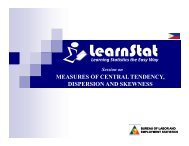Tripartite Validation Workshop of the Philippines Decent Work ...
Tripartite Validation Workshop of the Philippines Decent Work ...
Tripartite Validation Workshop of the Philippines Decent Work ...
You also want an ePaper? Increase the reach of your titles
YUMPU automatically turns print PDFs into web optimized ePapers that Google loves.
An alternative indicator may be generated from time use survey measuring <strong>the</strong> burden <strong>of</strong><br />
reproductive/care work. This would provide a better picture <strong>of</strong> <strong>the</strong> family and personal life<br />
<strong>of</strong> workers, and <strong>the</strong> burden on specific household members. Such data may be useful in<br />
informing <strong>the</strong> design <strong>of</strong> workplace programs promoting a balanced work and family life.<br />
An emerging issue that falls under this element <strong>of</strong> decent work concerns children left<br />
behind by overseas workers who are forced to assume <strong>the</strong> role <strong>of</strong> household head. In some<br />
cases this follows <strong>the</strong> death <strong>of</strong> an elderly household member to whom <strong>the</strong> family has been<br />
entrusted. This raises questions not only about how <strong>the</strong>se young people balance <strong>the</strong>ir own<br />
education, work, and family life, but also <strong>the</strong> extent to which <strong>the</strong> work <strong>of</strong> overseas<br />
Filipinos constitutes decent work (when it lacks an adequate work-family balance). This is<br />
one <strong>of</strong> many issues brought about by <strong>the</strong> phenomenon <strong>of</strong> overseas employment that<br />
challenge current definitions <strong>of</strong> “decent work.”<br />
With regard to <strong>the</strong> legal framework indicators, two shortcomings are identified: (i) <strong>the</strong><br />
indicators focus on women; and, (ii) most laws provide only leave benefits. There are<br />
existing policies that impact on work and family life but are not captured by <strong>the</strong> legal<br />
framework indicators, e.g. allocating a share <strong>of</strong> <strong>the</strong> government budget to gender<br />
programs. More generally, this raises <strong>the</strong> question as to whe<strong>the</strong>r <strong>the</strong> legal framework<br />
indicators based on laws and ratified ILO conventions adequately capture <strong>the</strong> relevant<br />
government interventions that facilitate or hinder <strong>the</strong> achievement <strong>of</strong> decent work goals.<br />
(See also Chapter 8)<br />
Statistical and legal indicators on this element <strong>of</strong> decent work can help policymakers<br />
formulate programs to benefit <strong>the</strong> economically inactive, formulation <strong>of</strong> better programs to<br />
promote gender equality, and mainstream reproductive/domestic work performed by<br />
women.<br />
4.7. Chapter 6: <strong>Work</strong> That Should Be Abolished<br />
The Pr<strong>of</strong>ile presents <strong>the</strong> proportion <strong>of</strong> working children to working population. A<br />
disaggregation <strong>of</strong> <strong>the</strong> data on working children by sector or industry would be useful and<br />
would highlight critical problems, including children engaged in <strong>the</strong> “sex-work” industry.<br />
Distinction should be made between child labour and working children (i.e. with work<br />
permits). This chapter underlines <strong>the</strong> need for data on child labour as well as statistics on<br />
problems associated with child labour. The latter would include “batang hamog” or<br />
children exploited by criminal elements, children in conflict with <strong>the</strong> law, children in areas<br />
<strong>of</strong> conflict, children in <strong>the</strong> sex industry, and so on.<br />
Statistics on child labour should be disaggregated by age, sex, occupation, industry,<br />
urban/rural, and so on. It must capture reasons for child work, work hours, and attendance<br />
in school. Regular child labour surveys are essential to monitor and assess this situation.<br />
In this regard, <strong>the</strong> Pr<strong>of</strong>ile will benefit from <strong>the</strong> release this year <strong>of</strong> <strong>the</strong> survey on working<br />
children. It is hoped that from this point on <strong>the</strong> survey on working children will be<br />
conducted by <strong>the</strong> NSO on a regular basis. Present law prescribes hours <strong>of</strong> work, but it is<br />
not easy to capture actual working hours <strong>of</strong> children.<br />
There may be a need to highlight <strong>the</strong> UN Convention on <strong>the</strong> Rights <strong>of</strong> <strong>the</strong> Child and PD<br />
No. 603 (Child and Youth Welfare Code). Deeper understandings <strong>of</strong> child labour –<br />
including its root causes- can result in more effective laws and policies.<br />
15



